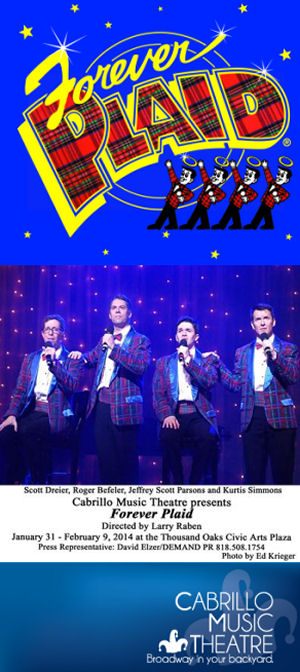
 There are just some shows that theatres just love to do. These shows don’t require fancy sets; they have small casts; and they please the audience. We saw one such show two weeks ago, “I Love You, You’re Perfect, Now Change” at Repertory East Playhouse (FB) (which is sold out for the remainder of the run). We saw another such show last night at Cabrillo Music Theatre (FB): “Forever Plaid“. The funny thing about this is that we saw the same two shows back in 2006, in the same order, at the same two theatres. Remember what I said about theatres loving these shows? [I’ll note we first saw “Forever Plaid” back in 1991 at the Pasadena Playhouse.]
There are just some shows that theatres just love to do. These shows don’t require fancy sets; they have small casts; and they please the audience. We saw one such show two weeks ago, “I Love You, You’re Perfect, Now Change” at Repertory East Playhouse (FB) (which is sold out for the remainder of the run). We saw another such show last night at Cabrillo Music Theatre (FB): “Forever Plaid“. The funny thing about this is that we saw the same two shows back in 2006, in the same order, at the same two theatres. Remember what I said about theatres loving these shows? [I’ll note we first saw “Forever Plaid” back in 1991 at the Pasadena Playhouse.]
“Forever Plaid” (written by Stuart Ross) isn’t a bad show — in fact, it is very much like it’s subject: harmonious, humorous, and completely inoffensive. “Forever Plaid” tells the story of the 4-man harmony group Forever Plaid, who was broadsided on the way to their first big gig by a bus full of parochial school girls who were on their way to see the Beatles on Ed Sullivan (exactly 50 years ago today). The musical “Forever Plaid” is the show that the Plaids were never able to put on in real life. As such, it is a collection of classic harmony songs from the 1950s and early 1960s, interspersed with some very humorous numbers and humorous patter.
I will note that I do have some favorite numbers in this show, which were all executed very well. These include the entire Ed Sullivan Show (in 3 minutes and some-odd seconds), which is very funny; “Perfidia”; the whole Heart and Soul audience interaction bit; the “Crazy ‘Bout Ya Baby” bit with the plungers; and the “Sixteen Tons”/”Chain Gang” number. To me, these are the best parts of the show.
During this show, I was watching the audience as well as the show (this is the third production of FB that I’ve seen). You could see this show was bringing back good memories: there were people singing along, people tapping their toes, people rocking in time to the harmonies. This show was hitting a good nerve, and people were leaving the theatre happy. This is a good thing.
Alas, while the show had few faults, the audience was a different story. There was a fellow in the Founders Circle who was seemingly texting for 80% of the show. There were the two young ladies sitting in front of me who used their cell phone to record “Perfidia”. There was another young couple who lit up their tablet at one point. My opinion: If you cannot exercise the self-restraint to turn off your cell-phone for 90 minutes and keep it in your pocket, you don’t belong in the theatre. You don’t belong in the movies either — you need to be reeducated in etiquette and how to behave in public places. Sorry, I’ll get off my soapbox now. Back to Forever Plaid. After all, they didn’t have cellphones in the early 1960s — and the audience better behave as if they were in that time!
Larry Raben, a former Plaid himself (indeed, we saw him as Sparky in the 1991 production), did a nice job directing this group of young men. The four Plaids themselves were, again, just like the musical itself: harmonious, humorous, and completely inoffensive. Their harmonies were tight and spot on; their humor worked well, and they had the uniform appearance that a group like this should have. About the only problem was individual: some of them were slightly off in their solo parts. The four Plaids were: Roger Befeler (Francis), Scott Dreier (Smudge), Jeffrey Scott Parsons (Sparky), and Kurtis Simmons (Jinx), and they were supported onstage by Alby Potts (Piano/Musical Director), and John Smith (Bass).
Technically, this is a simple show: four microphones, a piano, a bass, some projections, and loads of props. As such, there are no credits for set design or even the main prop design, although Alex Choate designed additional props. Jonathan Burke (FB), the resident sound designer at Cabrillo, did the sound for this show and it worked well. Jean-Yves Tessier did the lighting design, and it was problematic, for while the principal singer was always lit, often the other Plaids were in shadows or darkness. Gary Mintz was the technical director — and I’m guessing the man responsible for the projections — and he did a very nice job with those. However, his fog machine seemingly was creating problems for the people in the front row of the orchestra. There were no credits for the costumer or makeup artists — all were reasonably plaid, although one of the Plaids had this lock of hair that kept falling into his face. Additional technical credits: James Raitt (Musical Continuity and Arrangements); Kevin Traxler (Producer); Christine Steele (Company Manager); Phil Gold (Production Stage Manager); Kirsten D’Agostaro Shook (Assistant Stage Manager).
The last performance of “Forever Plaid” is today at 2pm at Cabrillo Music Theatre (FB). If you haven’t seen it before, it is a fun show to see. At this point, I’d suggest just going to the box-office at the Thousand Oaks Civic Arts Plaza to get tickets. Cabrillo has announced their 2014-2015 season; I wrote about it in this post and won’t repeat it. Oh heck, I will: it is “Memphis“, “Mary Poppins“, “Oklahoma“, and “Company” as a bonus show. Still haven’t decided if I’m going to resubscribe.
[Ob. Disclaimer: I am not a trained theatre critic; I am, however, a regular theatre audience. I’ve been attending live theatre in Los Angeles since 1972; I’ve been writing up my thoughts on theatre (and the shows I see) since 2004. I do not have theatre training (I’m a computer security specialist), but have learned a lot about theatre over my many years of attending theatre and talking to talented professionals. I pay for all my tickets unless otherwise noted. I believe in telling you about the shows I see to help you form your opinion; it is up to you to determine the weight you give my writeups.]
Upcoming Theatre and Concerts: Next weekend (February 16) brings Lysistrata Jones at The Chance Theatre (FB) in Anaheim. The next weekend, February 22 I’m doing a site visit to Portland OR for ACSAC, so if I see any theatre, it will be up there. The last day of February sees us in Studio City at Two Roads Theatre for Tom Stoppard’s “The Real Thing“, followed the next evening by the MRJ Regional Man of the Year dinner at Temple Beth Hillel. March theatre starts with “Sex and Education” at The Colony Theatre (FB) on March 8. (this might be good for March 16); The weekend of March 16 brings Purim Schpiels, with Sunday afternoon bringing “Inherit the Wind” at the Grove Theatre Center (FB) in Burbank. March 22 is being held for “Harmony” at The Ahmanson Theatre (FB). March concludes with “Biloxi Blues” at REP East (FB) on March 29. April will start with “In The Heights” at Cabrillo Music Theatre (FB) on April 5, and should also bring “Tallest Tree” at the Mark Taper Forum, as well as the Southern California Renaissance Faire. April may also bring “My Name is Asher Lev” at the Fountain Theatre (FB) (as this runs through April 19). As always, I’m keeping my eyes open for interesting productions mentioned on sites such as Bitter-Lemons, and Musicals in LA, as well as productions I see on Goldstar, LA Stage Tix, Plays411.


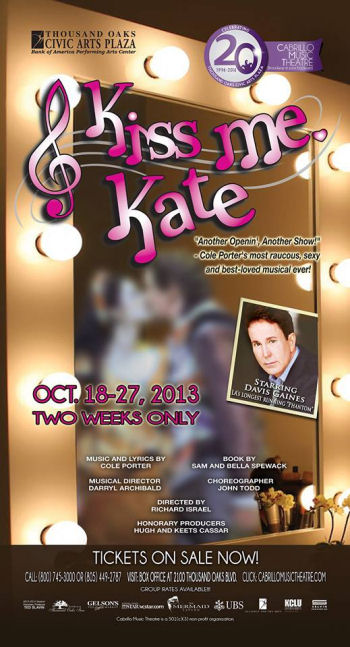
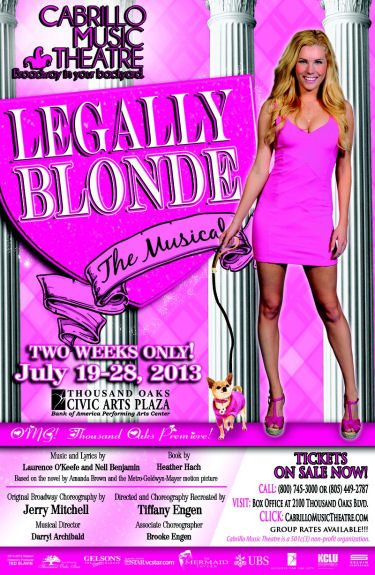
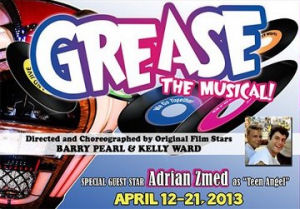
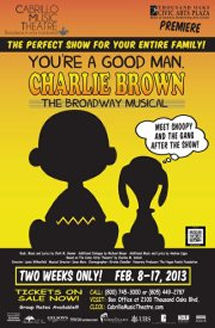
 Lucy, as portrayed by
Lucy, as portrayed by 